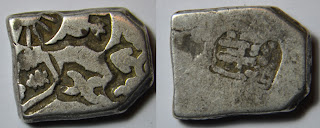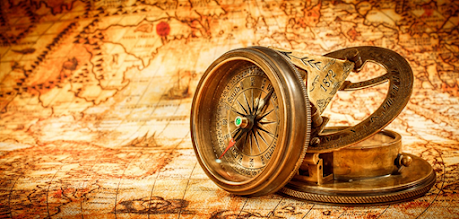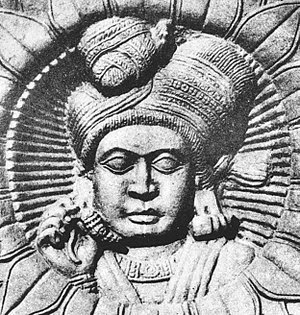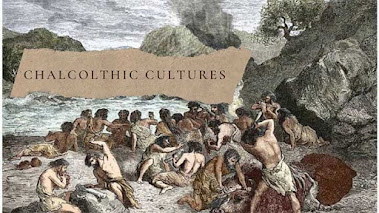The Rise and Downfall of Mighty Mauryan Empire : Bindusara and Ashoka
Bindusara
The Mauryan Empire Extended from Gandhara (present day Kandahar,Afghanistan) to Eastern Coast also known as Vanga (Present day West Bengal and Bangladesh) and till Mysore in the South According to Some Historians .
Bindusara was the Successor of Chandragupta Maurya as Second Mauryan Emperor of Bharat. He was also known as 'Amritghata' in Sanskrit and 'Amritchates' in Greek account, This name perhaps reflects a successful campaign in the Deccan. Bindusara’s campaign stopped in the vicinity of Karnataka, probably because the territories of the extreme south, such as those of the Cholas, Pandyas, and Cheras, were well-disposed in their relations toward the Mauryas.
Bindusara maintained friendly diplomatic relations with the Greeks. Deimachos of Plateia was the ambassador of Seleucid emperor Antiochus I at Bindusara's court.Deimachos seems to have written a treatise entitled "On Piety".
Historical evidence suggests that Bindusara died in the 270s
BCE.
Ashoka
Ashoka was the third ruler of the illustrious Maurya dynasty and was one of the most powerful kings of the Indian subcontinent in ancient times. His reign between 273 BC and 232 B.C. was one of the most prosperous periods in the history of India .According to Buddhist literature Ashoka was a cruel and ruthless monarch who underwent a change of heart after experiencing a particularly gruesome war, the Battle of Kalinga. After the war, he embraced Buddhism and dedicated his life towards dissemination of the tenets of the religion. He became a benevolent king, driving his administration to make a just and bountiful environment for his subjects. Owing to his benevolent nature as a ruler, he was given the title ‘Devanampriya Priyadarshi’.
Ashoka's title "Devanampiyena Piyadasi" (𑀤𑁂𑀯𑀸𑀦𑀁𑀧𑀺𑀬𑁂𑀦
𑀧𑀺𑀬𑀤𑀲𑀺)
in the Lumbini Minor Pillar Edict.
Ashoka was born to Mauryan King Bindusara and his queen Subhadrangi(also known as Dharma)He was appointed as Governer of Avanti(modern day Ujjain). Here he met and married Devi, the daughter of a tradesman from Vidisha. Ashoka and Devi had two children, son Mahendra and daughter Sanghamitra.
Bindusara became seriously ill and Sushima was nominated successor by the king but his autocratic nature made him unfavourable among the ministers. A group of ministers, led by Radhagupta, called upon Ashoka to assume the crown. Following Bindusara’s death in 272 B.C., Ashoka attacked Pataliputra, defeated and killed all his brothers, including Sushima. Among all his brothers he only spared his younger brother Vithashoka. His coronation took place four years after his ascent to throne. Buddhist literatures describe Ashoka as a cruel, ruthless and bad-tempered ruler. He was named ‘Chanda’ Ashoka meaning Ashoka the Terrible, due to his disposition at that time. He was attributed with building Ashoka’s Hell, a torture chamber manned by an executioner to punish offenders. After he became the emperor, Ashoka launched brutal assaults to expand his empire, which lasted for around eight years. Although the Mauryan Empire that he inherited was quite sizable, he expanded the borders exponentially. His kingdom stretched from Iran-Afghanistan borders in the West to Burma in the east. He annexed the whole of Southern India except Ceylon (modern day Sri Lanka). The only kingdom outside his grasp was Kalinga which is the modern day Orissa.
The Battle of Kalinga and Submission to Buddhism
Administration of Ashoka
The administration of Ashoka after his spiritual transformation was focused solely on the well-being of his subjects. The emperor was at the helm of the administration following the established model put forward by Mauryan Kings before Ashoka. He was closely assisted in his administrative duties by his younger brother, Vithashoka and a group of trusted ministers, whom Ashoka consulted before adopting any new administrative policy. The most important members of this advisory council included the Yuvraj (Crown Prince), the Mahamantri (Prime Minister), the Senapati (general), and the Purohita (priest). Ashoka’s reign saw introduction of a large number of benevolent policies as compared to his predecessors. He adopted a paternalistic view on administration and proclaimed "All men are my Children", as evident from the Kalinga edict. He also expressed his indebtedness to his subjects for bestowing with their love and respect, and that he considered it his duty to serve for their greater good.
Religious Policy: Ashoka’s Dhamma
1.To be liberal and avoid selfishness
2.To maintain a high moral character
3.To be prepared to sacrifice one's own pleasure for the well-being of the subjects
4.To be honest and maintain absolute integrity
5.To be kind and gentle
6.To lead a simple life for the subjects to emulate
7.To be free from hatred of any kind
8.To exercise non-violence
9.To practice patience
10.To respect public opinion to promote peace and harmony
Ashoka's Edicts:
1. No living being were to be slaughtered or sacrificed.
2. Medical care for human as well as animals throughout his Empire
3. Monks to tour the empire every five years teaching the principles of dharma to the common people.
4. One should always respect one’s parents, priests and monks
5. Prisoners to be treated humanely
6. He encouraged his subjects to report to him their concerns regarding the welfare of the administration at all times no matter where he is or what he is doing.
7. He welcomed all religions as they desire self-control and purity of heart.
8. He encouraged his subjects to give to monks, Brahmans and to the needy.
9. Reverence for the dharma and a proper attitude towards teachers was considered better than marriage or other worldly celebrations, by the Emperor.
10. Emperor surmised that glory and fame count for nothing if people do not respect the dharma.
11. He considered giving the dharma to others is the best gift anyone can have.
12. Whoever praises his own religion, due to excessive devotion, and condemns others with the thought "Let me glorify my own religion," only harms his own religion. Therefore contact (between religions) is good.
13. Ashoka preached that conquest by the dhamma is superior to conquest by force but if conquest by force is carried out, it should be 'forbearance and light punishment'.
14. The 14 edicts were written so that people might act in accordance with them.

Role in Dissemination of Buddhism
The third council of Buddhism was held under the patronage
of Emperor Ashoka. He also supported the Vibhajjavada sub-school of the
Sthaviravada sect, now known as the Pali Theravada.
Mahisamandala (Mysore) - Mahadeva
Vanavasi (Tamil Nadu) - Rakkhita
Aparantaka (Gujarat and Sindh) - Yona Dhammarakkhita
Maharattha (Maharashtra) - Mahadhammarakkhita
"Country of the Yona" (Bactria/ Seleucid Empire) -
Maharakkhita
Himavanta (Nepal) - Majjhima
Suvannabhumi (Thailand/ Myanmar) - Sona and Uttara
Lankadipa (Sri Lanka) - Mahamahinda
After ruling over the Indian subcontinent for a period of approximately 40 years, the Great Emperor Asoka died in 232 BC. After his death, his empire lasted just fifty more years.
Ashoka’s Legacy

Buddhist Emperor Asoka built thousands of Stupas and Viharas for Buddhist followers. One of his stupas, the Great Sanchi Stupa, has been declared as a World Heritage Site by UNESCO. The Ashoka Pillar at Sarnath has a four-lion capital, which was later adopted as the national emblem of the modern Indian republic.
Ashoka was followed for 50 years by a succession of weaker
kings. He was succeeded by Dasharatha Maurya, who was Ashoka's grandson. None
of Ashoka's sons could ascend the throne after him. Mahendra, his first born,
was on to spread Buddhism in the world. Kunala Maurya was blind hence couldn't
ascend the throne and Tivala, son of Kaurwaki, died even earlier than Ashoka.
Another son, Jalauka, does not have much story behind him.
The empire lost many territories under Dasharatha, which were later reconquered by Samprati, Kunala's son. Post Samprati, the Mauryas slowly lost many territories. In 180 BCE, Brihadratha Maurya, was killed by his general Pushyamitra Shunga in a military parade without any heir. Hence, the great Maurya empire finally ended, giving rise to the Shunga Empire.
Resources:
1.) https://www.culturalindia.net/indian-history/ancient-india/ashoka.html
2.)https://www.britannica.com/biography/Bindusara
3.)https://en.wikipedia.org/wiki/Ashoka
Image Credits:
1.)By Photo Dharma from Penang, Malaysia - This file has been extracted from another file: Lumbini - Pillar Edict in Brahmi Script, Lumbini (9241396121).jpg, CC BY 2.0, https://commons.wikimedia.org/w/index.php?curid=72851138
2.)By Sujit kumar - Own work, CC BY-SA 4.0, https://commons.wikimedia.org/w/index.php?curid=37744265
3.)By Avantiputra7 - Own work, CC BY-SA 3.0, https://commons.wikimedia.org/w/index.php?curid=33726301
4.)By mself - Own work, CC BY-SA 2.5, https://commons.wikimedia.org/w/index.php?curid=1762981
5.)By PHGCOM - Own work, CC BY-SA 3.0, https://commons.wikimedia.org/w/index.php?curid=2254206
6.)By Photo Dharma from Sadao, Thailand - 013 King Asoka visits Ramagrama, CC BY 2.0, https://commons.wikimedia.org/w/index.php?curid=58407942
NOTE :-
This blog is meant for Educational Purpose only .We do not own any Copyrights related to images and information , all the rights goes to their respective owners . The soul purpose of this blog is to Educate, Inspire, Empower and to create awareness in the viewers. The usage is non-commercial(Not For Profit) and we do not make any money from it.








Metablogs r really good intiative started by coep students giving the unknown knowledge of different fields keep going .. All the best..
ReplyDelete